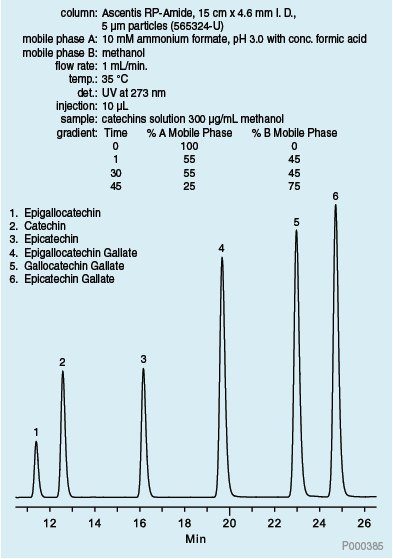Reference Standards for Analyzing Polyphenol Catechins
Catechins have become a hot topic in today’s health conscious world. Current research suggests that catechins aid health by:
- Reducing formation of athersclerotic plaques
- Suppressing the growth of tumors by inhibiting enzymes involved in the spread of cancer cells, eradicating tumor promoting substances and blocking chemical carcinogens
- Reducing high blood pressure
- Protecting against digestive and respiratory infections
- Lowering cholesterol levels
- Lowering blood glucose levels
- Prevention of kidney stones
- Reducing the chance of developing rheumatoid arthritis
- Producing stronger bones
- Reducing inflammation
The catechins are a group of polyphenolic compounds exhibiting strong anti-oxidant, as well as, remarkable antibacterial, antiviral, and anti-inflammatory properties. They are found in high concentrations in the leaves of Camellia sinensis (tea) and in smaller amounts in chocolate, grapes, raspberries, apples, pears, and wine. The very young leaves and buds of Camellia sinensis used to make white tea have the highest concentrations; followed by the slightly more mature leaves used to make green tea. Older leaves used to make Oolong and black teas are more oxidized and contain higher concentrations of other polyphenols including theaflavanins and thearubigins.
Catechins, like other antioxidants, help protect cells from oxidative stress. Oxygen is vital to life; however, it is also incorporated into reactive oxygen species including hydrogen peroxide, hypochlorous acid and free radicals such as the hydroxyl radical and the superoxide anion. Reactive oxygen species damage cells and have been implicated in the slow chain reaction of damage leading to heart disease, cancer, and many other ailments. Antioxidants function by preventing the formation of reactive oxygen species, or by reacting with them before they can damage cells.
Leaves of Camellia sinensis contain at least eight polyphenol catechins. The six predominant catechins in tea leaves are catechin, gallocatechin gallate(GCG), epigallocatechin (EGC), epicatechin (EC), epicatechin gallate (ECG) and epigallocatechin gallate (EGCG), with EGCG being the most abundant.
Analytical Challenge
Analysts determining catechin concentrations are challenged by the lack of commercially available catechin reference solutions. One option is to prepare reference standards in-house from the individual catechin compounds. This is typically not a cost effective solution due to the following:
- High-purity catechin compounds are often difficult to find and are very expensive.
- Catechins, both neat and in solution, require proper storage.
- They are sensitive to heat, light, and air.
- Preparing standards is a time-consuming process
Our Solution
To meet this need, eight catechin analytical reference standard solutions were developed. These Supelco-brand standards are prepared, dispensed, packaged, and stored to minimize chemical degradation and provide maximum shelf life. Each standard comes with a Certificate of Analysis that includes a purity determination. Catechins may also be prepared in specifically tailored combinations of concentration, components, and solvent utilizing our custom chemical standards program. Additionally, a simple, robust LC-UV method using the Ascentis RP-Amide column was developed (Figure 1). The method is also compatible with MS detection. It provides reproducible analytical results and excellent peak shape.

Figure 1.HPLC Analysis of Six Primary Green Tea Catechins (565324-U)
Materials
References
To continue reading please sign in or create an account.
Don't Have An Account?